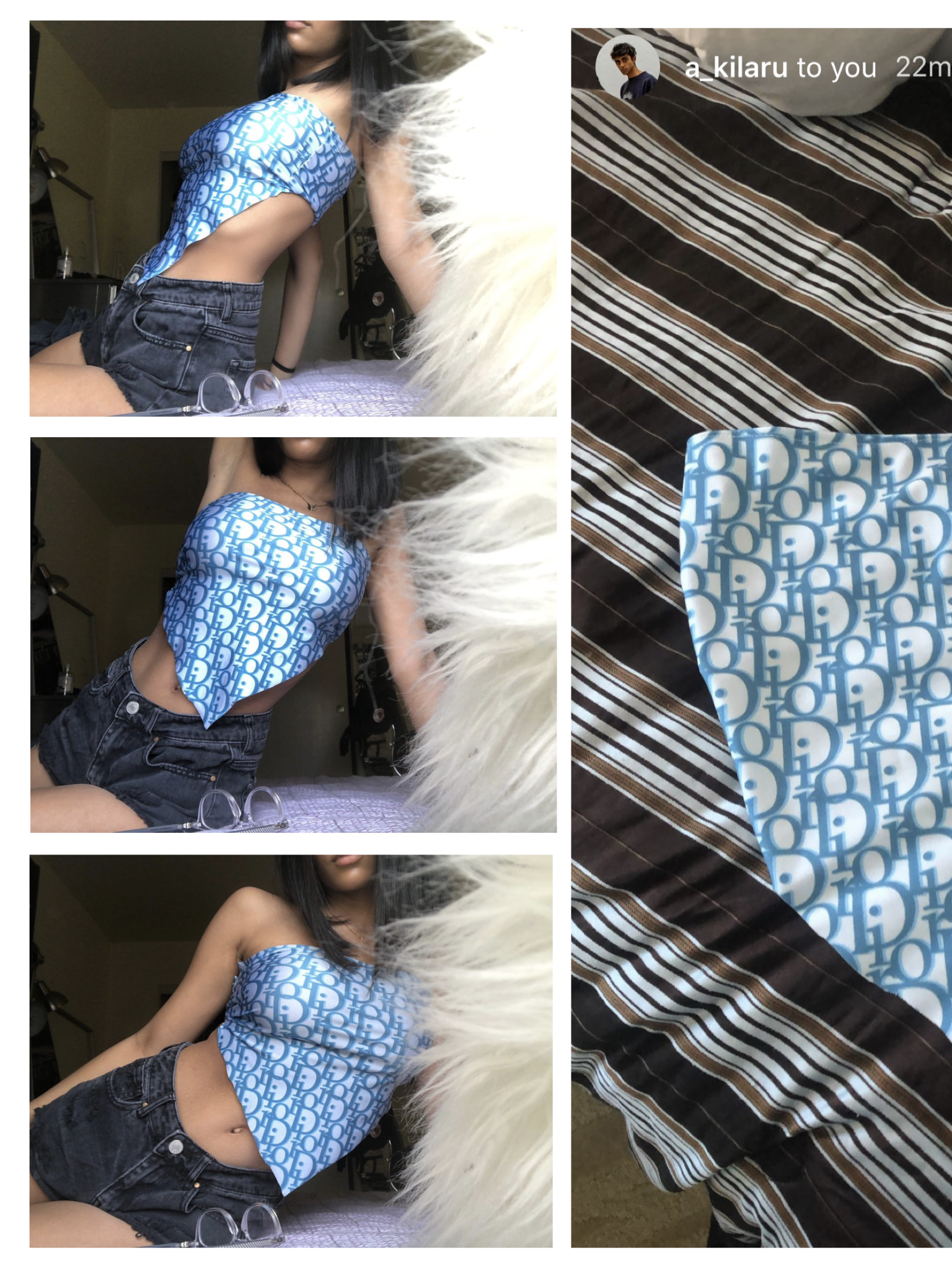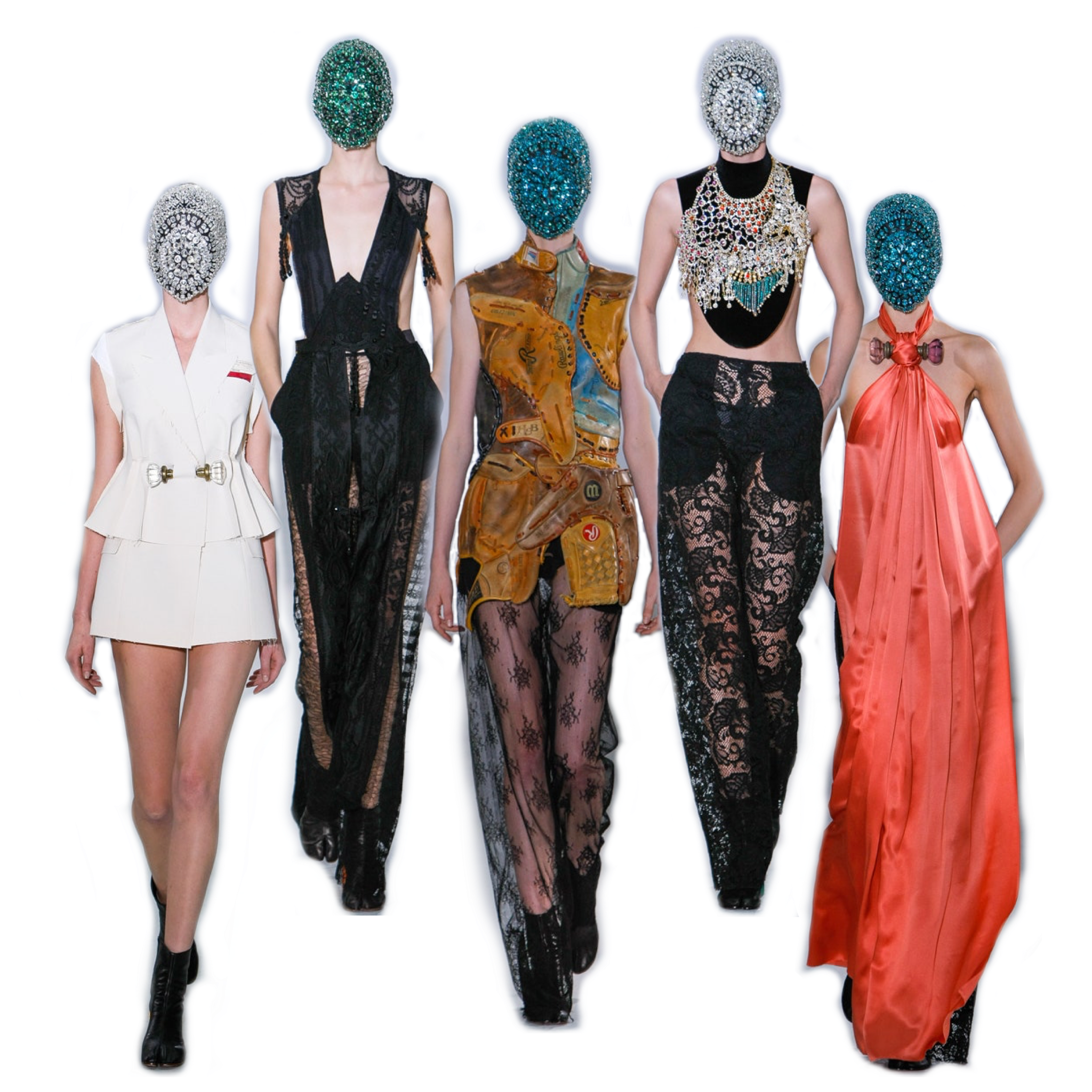Quarantine Skillshare: Arjun Kilaru’s Norm-Shifting, Logomania-Influenced Designs
Arjun Kilaru is a first-year probably majoring in some combination of economics, statistics, and sociology. He is involved with MODA Magazine and designed in the Winter 2020 Fashion Show and also produces for the UChicago Public Policy Podcasts.
In the beginning of isolation, there was an incredible panic and shortage related to the distribution of masks. Now, as it has been mandated for people to wear masks while in public, increasingly more are teaching themselves to sew. Arjun Kilaru sits in a privileged place, amongst a family with a history of fashion design work, but advocates for learning how to sew by trial and error (he says that the seam ripper will be your best friend!).
Arjun Kilaru chats with me about the inspiration behind his utilization of a mask in his MODA W’20 Collection, designing clothes for his girlfriend, and trends that originated on the runway that will hopefully be integrated into the mainstream. The conversation that follows has been edited for clarity and length.
Ariana Garcia: When did you start designing and sewing?
Arjun Kilaru: So I first really started when I started [my collection] for the [MODA Fashion] Show. That was my first brush with it, but I knew a little bit before that because my mom used to make clothes as a designer and my grandma does too. It’s a really present thing in my family. So I kind of did the Show as a way to build that part of myself and I really learned a lot and I made something to be proud of.
Can you tell me more about the history of design in your family?
Yeah, so my grandma was a fashion designer and a tailor. She's been doing that for a super long time, from back when she was in India and Pakistan. My mom went to college for fashion design, which is what she did for her twenties before she came here. They both just have all this experience and gave me help and tips and showed me better ways to do things. The whole reason I [learned to sew and design] was to gain deeper connections with that aspect of my family that I hadn't really explored before.
Bandeau Top Designed and Made By Arjun Kilaru, Modeled by @eshadkr
Have you noticed, from being taught by them, that there are specific habits that you have picked up?
They take a ton of measurements and to make it very specific for the person. I think that the clothes are more important than the person, which is one thing that we clash on. One reason why [they take a lot of measurements is because] they create formal wear, which is also why some of my pieces have a formal sense to them, like the collars and the dress.
Why do you think the clothes are more important than the person?
I've always made clothes for the purpose of them being shown at an exhibition. Whereas they make clothes to sell them to people and because people commission them, which is why they really focus on the person that they're making pieces for. I have never done it that way. But, I understand that [clothes are designed for different reasons].
Do you think that you usually tend to design towards either a person or towards a larger collection of work?
I usually make something to teach a technique to myself. [In terms of the two-piece set], I had never made a bikini top before and I wanted to learn by figuring it out through trial and error.
The best tool I have is not the [sewing] machine, but the seam ripper. It takes apart the mistakes I made, so I can [go back and learn by redoing it]. This is important because I want to learn as many techniques as I can now so I can apply that to a collection later. Whenever I'm making something, the first thing I think is like, okay, what can I learn by making this?
Two-Piece Set Made During Quarantine, via Arjun Kilaru
As a follow-up to the picture you sent me of a two-piece set that you made for your girlfriend, what is the process like when you are designing something for a specific person versus when you are designing for a model or to explore some theme?
Before I start making something for someone, I already know what I want to make beforehand. I start with a sketch and then I pick a model. The way I [made the two-piece set in quarantine] is that I had an idea, took the measurements, and basically drafted a pattern using the little amount of fabric I had. It turned out really well! It’s really easy for me to alter it and make the design fit the person.
Is there a difference between what you created for the Show and what you do outside of that?
For the Show, I had a theme that I really wanted to follow, which was using florals as a way to comment on gender. All of the measurements were exactly to fit the models. Whereas what I make on my own, I work with what materials I have and I'm not following any specific patterns; I'm doing whatever I want and eyeballing it. For example, right now I have just been buying some fabric online and picking out something in my closet and making something similar by cutting a template from it. It's a lot more freeing and I'm building my own skills.
Alessandro Trincone’s Avvolgimi SS19 NYFW Show, pictures accessed via Trincone’s Website
Who or what inspired your MODA collection?
I really like the work of Alessandro Trincone (featured above). He put out this really amazing collection, which had a bunch of awesome dresses that I really admired, and all the models were male. I thought it was super, super cool and it definitely inspired me
Another big inspiration is a Margiela collection, F/W’12, where they created these masks where you couldn’t see the face of the models at all. I thought that represented a lot and I definitely tried to build upon that theme of hiding your face. For MODA, I made a chainmail mask for my collection last year, but I think that that theme can go further.
Maison Margiela F’12 Couture Collection, pictures accessed via Vogue
I like the symbolism of masks because they make you think about disguising yourself and your face and maybe becoming more anonymous or even taking on a character. I feel like there is a weird contradiction in there, right? Because, in some regards, you are trying to hide yourself, but through embellishment. A viewer is meant to be looking at something that you are obstructing. Do you think that fashion does the same work of both hiding yourself and being eye-catching?
Yeah, I think that there's so much you can do with [certain pieces], so it really depends on what you want to get out of it. If you want to use fashion as a way to blend in or become more anonymous, you can do that. On the other side, if you want to stand out and draw that attention to yourself, you can do that as well. The style that I find interesting is the one where you don't know which objective they're going for, and that’s what the masks symbolize to me. I wanted the mask I made to hide the model and reflect the subconsciously desire to be seen, through that ornate design.
Arjun Kilaru MODA W’20, runway photography by Elliot Duprey
Where do you think your designs are going forward from MODA ?
I definitely learned a lot from the other designers, in terms of techniques and themes. I was just super observant of everything that I saw. There were themes of combining men's and women's fashion in a very direct way. It's more subtle the way that I did. [But, I want to play off of that and put out my own version of that in the future].
How would you describe where your personal style is right now?
I tend to like stuff that I see on red carpets and much less that I just see people wearing on the street. I [try to integrate styles] that I find unconventional and have fun with how I decide to wear it. I really like kimonos and I have like four or five that I'll throw on and layer two at the same time. I don’t really care what the overall trends are. Sometimes what I wear are just random things that I really gravitate towards, like headscarves and masks. I just go with it and see what looks good.
Arjun Kilaru MODA W’20, runway photography by Elliot Duprey
How has being in quarantine affected your materials or techniques utilized in your designs?
It definitely makes the stuff that I make somewhat less risky because I know that if I mess up, I can ruin the fabric by cutting it the wrong size. [At that point, I can’t] fix it. [I don’t have access to fabric stores], like I did when I was designing for MODA. Then, I knew that the worst thing that would happen would be that I have to replace the fabric I had. I also was able to go to the fabric store multiple times for at least an hour each time. The main things that I looked for were colors that go together and the relative durability of the fabrics. It was cool to figure out how I can use their strengths. For example, velvets are a really formal fabric and I wanted to match that with denim because that's not something that you see very often. But what I didn't know is how hard velvet and denim are to sew. At the end of the day, I learned a lot from using them. Now, what I mainly look for in a fabric is how they convey the message or theme of the collection and their ease of use.
Now, in quarantine, I'd have to pay [for shipping] and wait another two weeks for it. It's a lot harder, which is why I've been making stuff that will still teach me and help me grow, but I know I can be safe with and use up fabric I already had.
A lot of people in quarantine have started picking up sewing just so they are able to make functional masks for themselves, their families, and to donate. Do you think this introduction of people wearing masks made from whatever materials and fabrics that they have on hand will eventually make it into the fashion mainstream? What advice would you give to someone finally introducing themselves to sewing?
Yeah, I mean for the Show I also made three or four of those types of masks, and almost went with that design instead. They are really easy to make. I hope that most people who are picking that skill up and will feel like they can make more items on their own. I'm really excited to see more people getting into sewing and designing and I definitely think that it'll build.
People are teaching things to themselves right now. And like 90% of how I learned to make clothing was from YouTube and asking around. Anything is completely possible. If I was able to go from knowing nothing to creating [an entire collection in a few months], then anyone can, for sure. Especially right now, if you have spare fabric or whatever, you can even use old curtains or old clothing, to teach yourself how and have fun experimenting. I think like you'll learn a lot more than you think.
Arjun Kilaru’s Norm-Shifting, Logomania-Influenced Designs
Featured Images via Arjun Kilaru
All Included Collages Made By Ariana Garcia
















